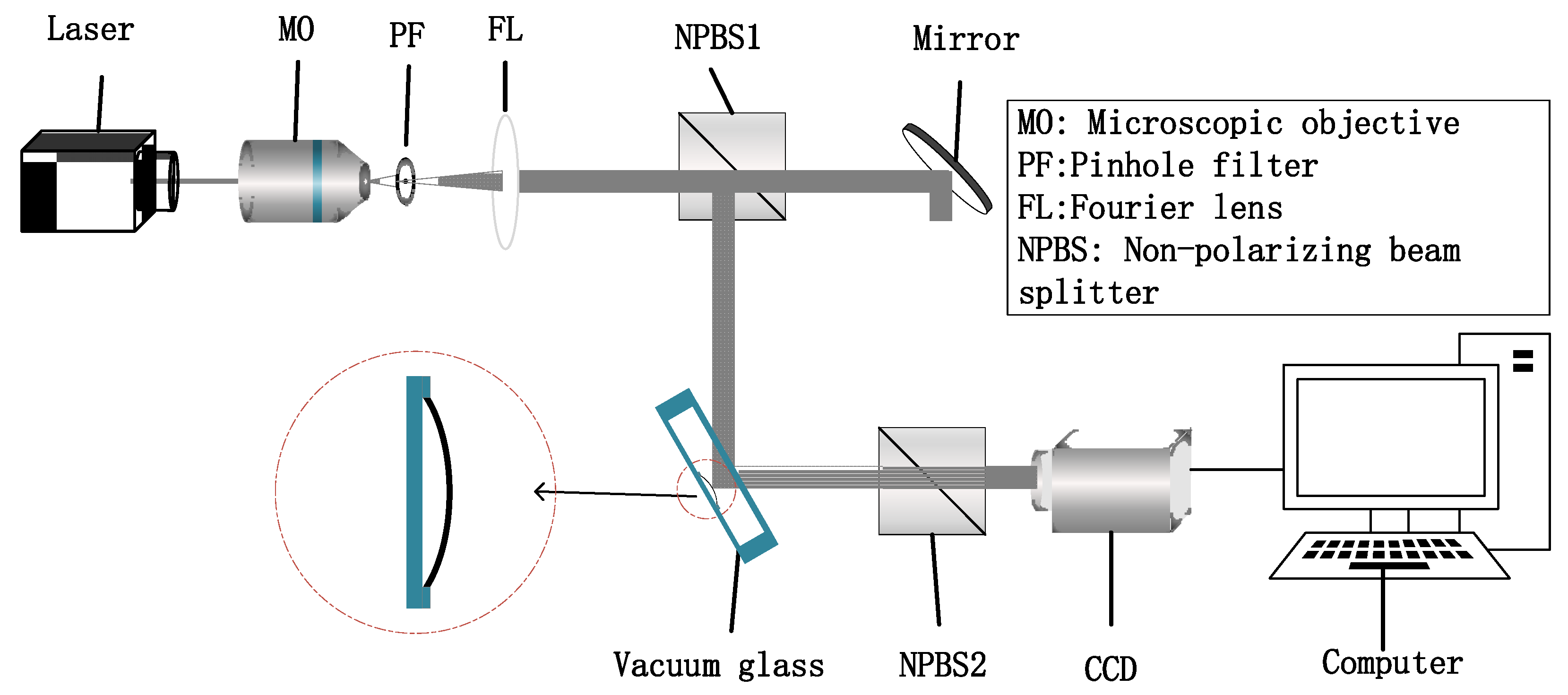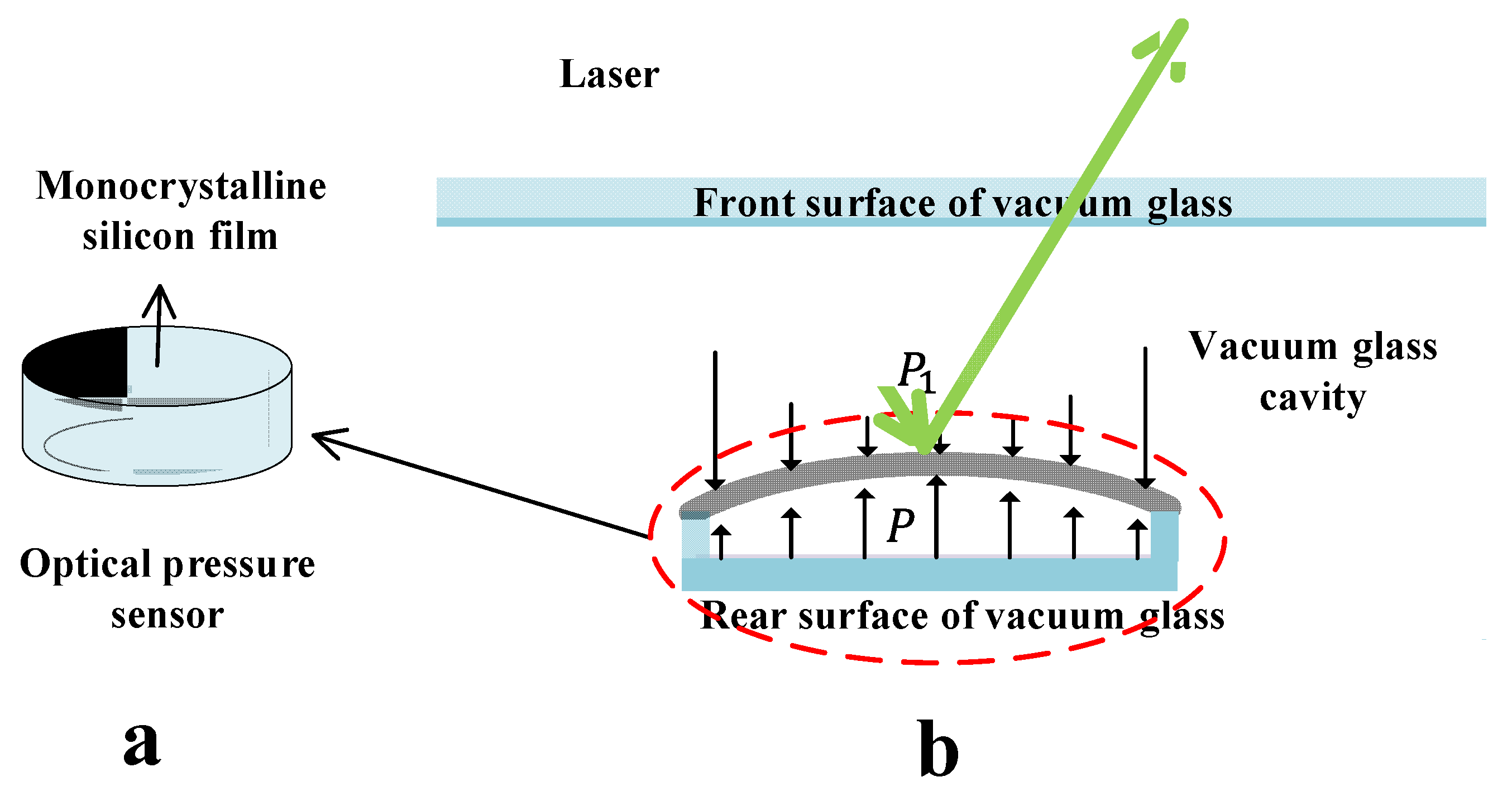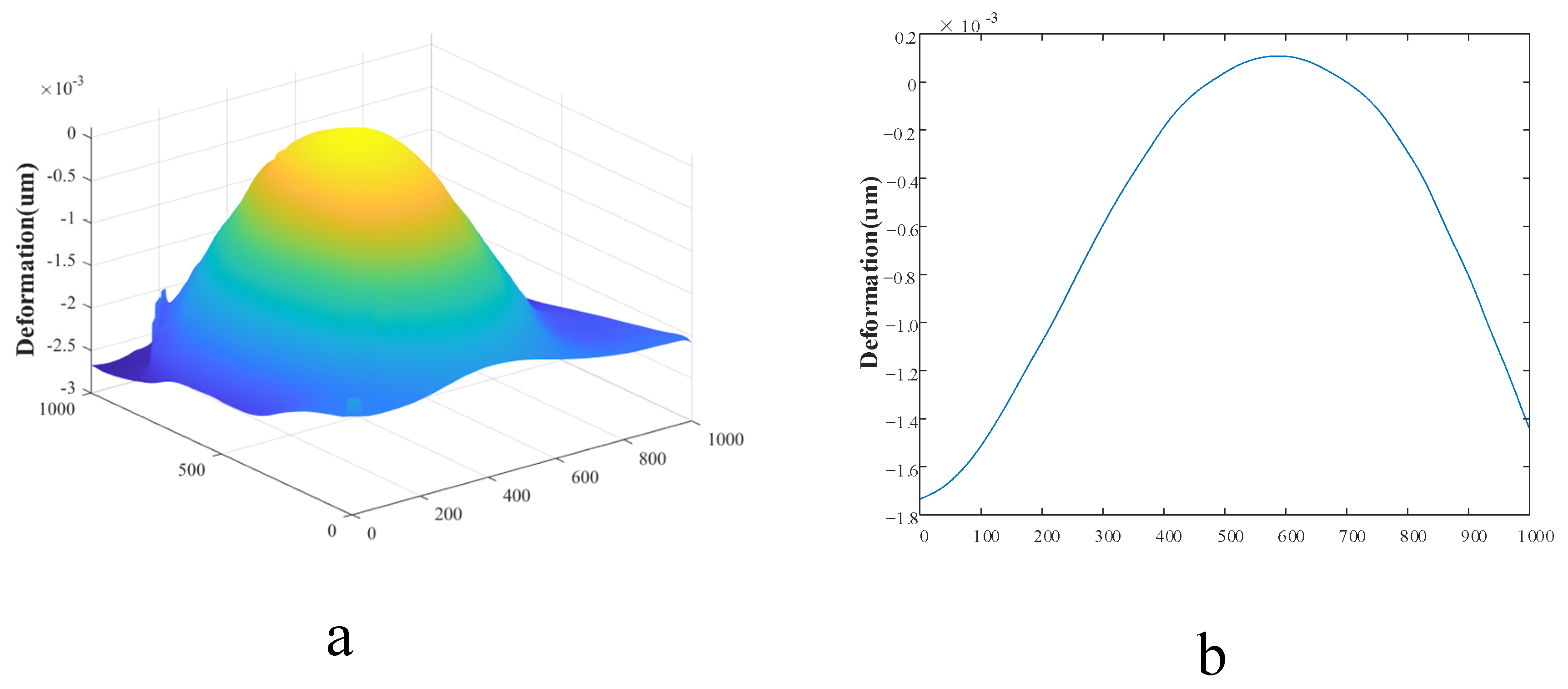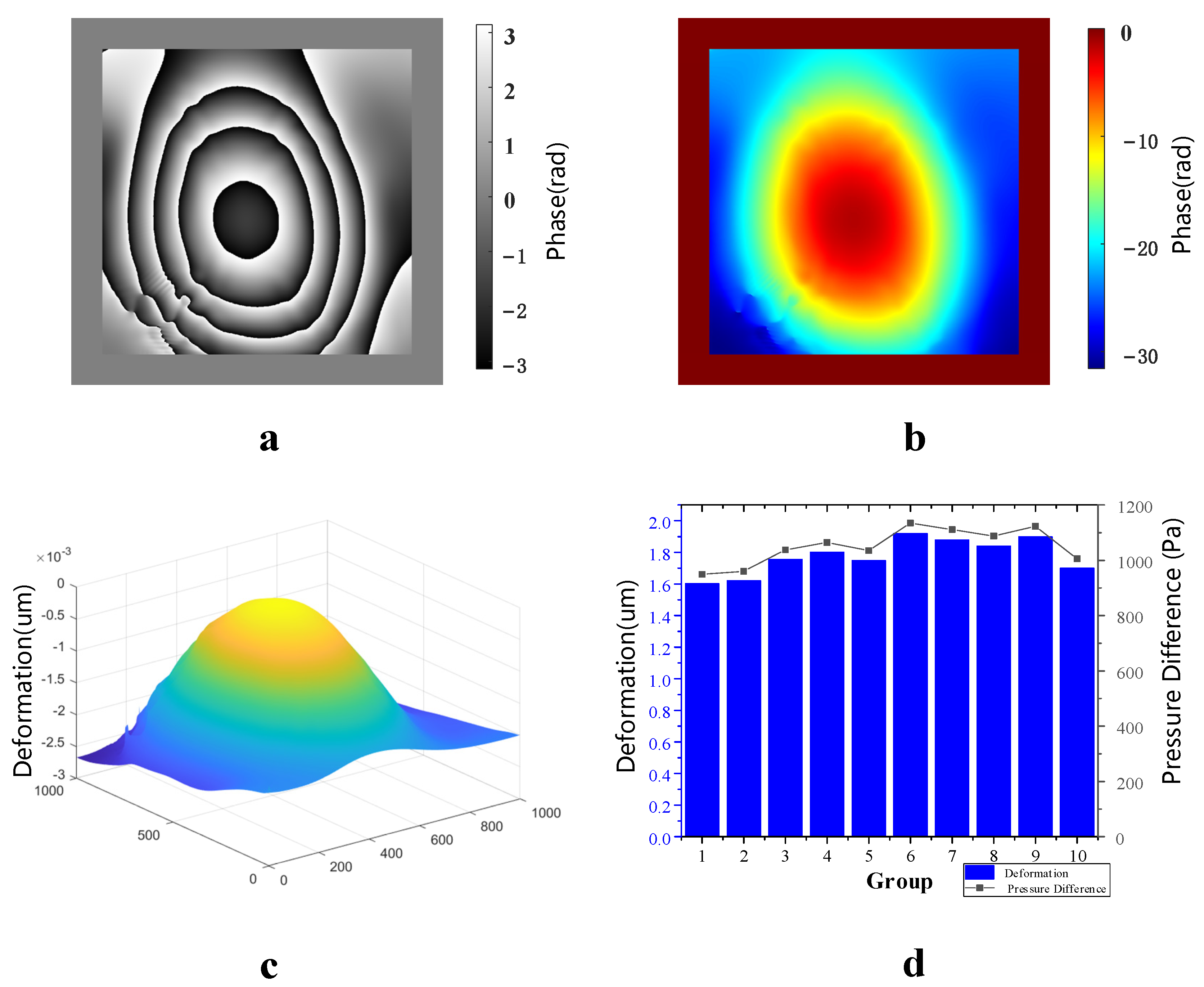A Method for Detecting the Vacuum Degree of Vacuum Glass Based on Digital Holography
Abstract
:1. Introduction
2. Principle and Methods
2.1. Principle of Digital Holography
2.2. Digital Holographic Optical Path
2.3. Optical Pressure Sensor
2.3.1. Basic Theory
2.3.2. Preparation Method
3. Results and Discussion
3.1. Deformation Measurement of Monocrystalline Silicon Film in the Optical Pressure Sensor
3.2. Variation in Vacuum Degree with Optical Pressure Sensor Deformation
3.3. Application of Vacuum Degree Measurement of Vacuum Glass
4. Conclusions
Author Contributions
Funding
Institutional Review Board Statement
Informed Consent Statement
Data Availability Statement
Acknowledgments
Conflicts of Interest
References
- Collins, R.E.; Robinson, S.J. Evacuated glazing. Sol. Energy 1991, 47, 27–38. [Google Scholar] [CrossRef]
- Shi, Y.J.; Xi, X.B.; Zhao, G.L.; Zhang, Y.F.; Cai, D.; Zhang, J.F.; Xu, H.Y.; Zhang, R.H. Sealing performance of tempered vacuum glazing with silver oxide system low melting solder. Mater. Chem. Phys. 2022, 275, 125202. [Google Scholar] [CrossRef]
- Uddin, M.M.; Wang, C.Y.; Zhang, C.Y.; Ji, J. Investigating the energy-saving performance of a CdTe-based semi-transparent photovoltaic combined hybrid vacuum glazing window system. Energy 2022, 253, 124019. [Google Scholar] [CrossRef]
- Wang, L.; Omary, G.; Wang, Y.Q.; Nomenjanahary, H.F.; Li, H. Intelligent modelling to predict heat transfer coefficient of vacuum glass insulation based on thinking evolutionary neural network. Artif. Intell. Rev. 2020, 53, 5907–5928. [Google Scholar]
- Zhang, J.F.; Liu, S.X.; Zhang, Y.J.; Miao, H.; Zhang, S.W.; Zhang, Q. Formation mechanism of sealing edge pores for vacuum glazing using laser brazing technique. Vacuum 2018, 147, 1–7. [Google Scholar] [CrossRef]
- Collins, R.E.; Fischer-Cripps, A.C.; Tang, J.Z. Transparent evacuated insulation. Sol. Energy 1992, 49, 333–350. [Google Scholar] [CrossRef]
- Lv, Q.H.; Cui, J.C.; Jarimi, H.; Lv, H.; Zhai, Z.S.; Su, Y.H.; Riffat, S.; Dong, S.J. Theoretic analysis and experimental evaluation of the spectrum transmission coefficient of a multilayer photovoltaic vacuum glazing. Int. J. Low-Carbon Technol. 2020, 15, 574–582. [Google Scholar] [CrossRef]
- Huang, J.C.; Wang, Q.L.; Chen, X.; Xu, S.Y.; Yang, H.X. Experimental investigation and annual overall performance comparison of different photovoltaic vacuum glazings. Sustain. Cities Soc. 2021, 75, 103282. [Google Scholar] [CrossRef]
- Liu, X.G.; Xu, H.F.; Wang, Z.J.; Bao, Y.W. Semiquantitative test method for degradation ratio of vacuum degree of vacuum glazing by photoelastic method. Key Eng. Mater. 2016, 3799, 44–47. [Google Scholar] [CrossRef]
- Han, X.D.; Li, G.; Xu, M.H.; Guo, C.M.; Wang, Y.J.; Feng, Y.J.; Li, D.T. Miniature capacitance diaphragm gauge for absolute vacuum measurement. Measurement 2022, 194, 110851. [Google Scholar] [CrossRef]
- Wang, C.X.; Hou, Z.Q.; Kuang, Y.B.; Wu, Y.L.; Zhang, Y.M.; Wu, X.Z.; Xiao, D.B. A newly MEMS vacuum gauge with multi-modes for low vacuum measurement. Vacuum 2021, 192, 110446. [Google Scholar] [CrossRef]
- Shen, C.H.; Chen, S.J.; Lin, S.H. Research on a new Metal-N-Poly thermoelectric material sensor for vacuum sensing with self heating. Key Eng. Mater. 2018, 4687, 152–156. [Google Scholar] [CrossRef]
- Guo, S.; Feng, L.; Chen, S.; Ji, Y.; Peng, X.; Xu, Y.; Yin, Y.; Wang, S. Design of a high sensitivity pirani gauge based on vanadium oxide film for high vacuum measurement. Sensors 2022, 22, 9275. [Google Scholar] [CrossRef] [PubMed]
- Taekyung, H.; Hyunjung, S. Vacuum leak detection method using index regression and correction for semiconductor equipment in a vacuum chamber. Appl. Sci. 2021, 11, 11762. [Google Scholar]
- Javidi, B.; Carnicer, A.; Anand, A.; Barbastathis, G.; Chen, W.; Ferraro, P.; Goodman, J.W.; Horisaki, R.; Khare, K.; Kujawinska, M.; et al. Roadmap on digital holography. Optics 2021, 29, 35078–35118. [Google Scholar]
- Cai, X.O.; Hu, F.J.; Wang, H. Three-dimensional shape measurement based on dual-refractive-index digital holography. Optics Commun. 2015, 350, 252–256. [Google Scholar] [CrossRef]
- Seifi, M.; Denis, L.; Fournier, C. Fast and accurate 3D object recognition directly from digital holograms. J. Opt. Soc. Am. A Opt. Image Sci. Vis. 2013, 30, 2216–2224. [Google Scholar] [CrossRef] [Green Version]
- Khan, J. 3D digital holograms visualize biomedical applications. Laser Focus World 2013, 49, 55–58. [Google Scholar]
- Rastogi, V.; Agarwal, S.; Kumar, V.; Shakher, C. Holographic optical element based digital holographic interferometer for the study of macro flames, micro flames and their temperature instability. Opt. Lasers Eng. 2019, 122, 29–36. [Google Scholar] [CrossRef]
- Lu, W.; Shi, Y.; Ou, P.; Zheng, M.; Tai, H.X.; Wang, Y.H.; Duan, R.N.; Wang, M.Q.; Wu, J. High quality of an absolute phase reconstruction for coherent digital holography with an enhanced anti-speckle deep neural unwrapping network. Opt. Express 2022, 30, 37457–37469. [Google Scholar] [CrossRef]
- Manoj, K.; Chandra, S. Experimental characterization of the hygroscopic properties of wood during convective drying using digital holographic interferometry. Appl. Opt. 2016, 55, 960–968. [Google Scholar]
- Li, H.X.; He, G.J.; Song, Q.H.; Xia, H.T.; Liu, Z.Q.; Liang, J.; Li, T. The study of tooth erosion tested by the color digital holography (CDH) detection system. Appl. Sci. 2022, 12, 8613. [Google Scholar] [CrossRef]
- Li, J.C.; Fan, Z.B.; Tankam, P.; Song, Q.H.; Picart, P. The study of color digital holography free from the zero-order diffraction interruption. Acta Phys. Sin. 2011, 60, 256–261. [Google Scholar]
- Xia, H.T.; Guo, R.X.; Fan, Z.B.; Cheng, H.M.; Yang, B.C. Non-invasive mechanical measurement for transparent objects by digital holographic interferometry based on iterative least-squares phase unwrapping. Exp. Mech. 2012, 52, 439–445. [Google Scholar] [CrossRef]
- Kaur, I.; Lata, P.; Singh, K. Forced flexural vibrations in a thin nonlocal rectangular plate with Kirchhoff’s thin plate theory. Int. J. Struct. Stab. Dyn. 2020, 20, 17. [Google Scholar] [CrossRef]
- Paul, S.; Nordgren, R.P. Small Elastic Deformations of Thin Shells. J. Appl. Mech. 1976, 43, 702. [Google Scholar]
- Clausen, W.E.; Leissa, A.W. Deflection of a circular plate having mixed boundary conditions. AIAA J. 2012, 5, 2287–2288. [Google Scholar]
- Montresor, S.; Tahon, M.; Laurent, A.; Picart, P. Computational de-noising based on deep learning for phase data in digital holographic interferometry. APL Photonics 2020, 5, 030802. [Google Scholar] [CrossRef] [Green Version]
- Sui, X.M.; He, Z.H.; Zhang, H.; Cao, L.C.; Chu, D.P.; Jin, G.F. Spatiotemporal double-phase hologram for complex-amplitude holographic displays. Chin. Opt. Lett. 2020, 18, 19–22. [Google Scholar] [CrossRef]
- Terbe, D.; Orzó, L.; Zarándy, A. Classification of holograms with 3D-CNN. Sensors 2022, 22, 8366. [Google Scholar] [CrossRef]
- Chen, L.Z.; Tian, S.Z.; Zhang, H.; Cao, L.C.; Jin, G.F. Phase hologram optimization with bandwidth constraint strategy for speckle-free optical reconstruction. Opt. Express 2021, 29, 11645–11663. [Google Scholar] [CrossRef] [PubMed]
- Yu, H.Y.; Guo, Z.; Zhao, D.; Liu, P. Mechanical characteristics of origami mechanism based on thin plate bending theory. J. Appl. Mech. 2019, 86, 081008. [Google Scholar]
- Völklein, F.; Meier, A. Microstructured vacuum gauges and their future perspectives. Vacuum 2007, 82, 420–430. [Google Scholar] [CrossRef]










| Diameter/mm | Thickness/mm | Density/(kg/m3) | Elastic Modulus/Gpa | Poisson’s Ratio |
|---|---|---|---|---|
| 14 | 0.1 | 2330 | 180 | 0.2 |
Disclaimer/Publisher’s Note: The statements, opinions and data contained in all publications are solely those of the individual author(s) and contributor(s) and not of MDPI and/or the editor(s). MDPI and/or the editor(s) disclaim responsibility for any injury to people or property resulting from any ideas, methods, instructions or products referred to in the content. |
© 2023 by the authors. Licensee MDPI, Basel, Switzerland. This article is an open access article distributed under the terms and conditions of the Creative Commons Attribution (CC BY) license (https://creativecommons.org/licenses/by/4.0/).
Share and Cite
Li, T.; Song, Q.; He, G.; Xia, H.; Li, H.; Gui, J.; Dang, H. A Method for Detecting the Vacuum Degree of Vacuum Glass Based on Digital Holography. Sensors 2023, 23, 2468. https://doi.org/10.3390/s23052468
Li T, Song Q, He G, Xia H, Li H, Gui J, Dang H. A Method for Detecting the Vacuum Degree of Vacuum Glass Based on Digital Holography. Sensors. 2023; 23(5):2468. https://doi.org/10.3390/s23052468
Chicago/Turabian StyleLi, Ting, Qinghe Song, Guangjun He, Haiting Xia, Haoxiang Li, Jinbin Gui, and Haining Dang. 2023. "A Method for Detecting the Vacuum Degree of Vacuum Glass Based on Digital Holography" Sensors 23, no. 5: 2468. https://doi.org/10.3390/s23052468





